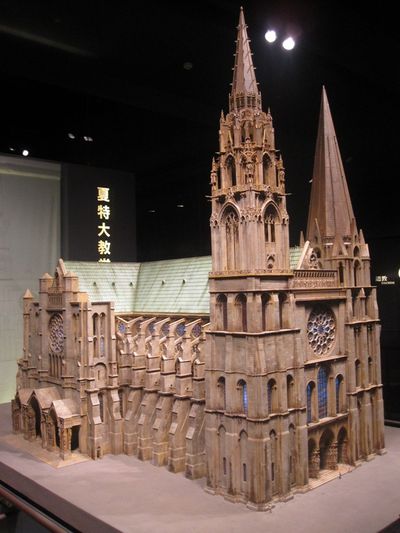Chartres Cathedral: Difference between revisions
imported>Chunbum Park No edit summary |
imported>Chunbum Park No edit summary |
||
| Line 1: | Line 1: | ||
{{subpages}} | {{subpages}} | ||
{{Image|Chartres Cathedral front view.png|right|350px|The front of the cathedral at Chartres.}} | {{Image|Chartres Cathedral front view.png|right|350px|The front of the cathedral at Chartres.}} | ||
'''Chartres Cathedral''' (''Cathédrale Notre-Dame de Chartres''<ref name="deparis">''Cathédrale Notre-Dame de Chartres'' is different from ''Cathédrale Notre-Dame de Paris'', which is colloquially known as [[Notre Dame de Paris]]</ref>) is a great [[cathedral]] in [[Chartres]], [[France]]. It was built | '''Chartres Cathedral''' (''Cathédrale Notre-Dame de Chartres''<ref name="deparis">''Cathédrale Notre-Dame de Chartres'' is different from ''Cathédrale Notre-Dame de Paris'', which is colloquially known as [[Notre Dame de Paris]]</ref>) is a great [[cathedral]] in [[Chartres]], [[France]]. It was built in the [[Gothic architecture|Gothic architectural style]] over the burned ruins of an ongoing project to modernize a previous wood-roofed [[Romanesque architecture|Romanesque]] church. | ||
The church was the center of [[Mariolatry]] in France as it housed a gift acquired from [[Constantinople]] by [[Charles the Bald]] presumed to be the tunic which was worn by [[Virgin Mary]] at [[Jesus]]'s [[Nativity of Jesus|nativity]]. The new facade | The church was the center of [[Mariolatry]] in France as it housed a gift acquired from [[Constantinople]] by [[Charles the Bald]] presumed to be the tunic which was worn by [[Virgin Mary]] at [[Jesus]]'s [[Nativity of Jesus|nativity]]. The old choir and the new facade that was begun in the previous year survived the fire, which also befell on a large part of the town on June 10, 1194, and along with them the tunic, which was preserved in the crypt below the Romanesque choir. With the priests' explanation to the townspeople that Mary wished to be restored in even greater magnificence, constructions started anew right away to fulfill her wish. | ||
The limit placed on the [[nave]]'s length by the [[fault (geology)|fault]] that occurs to the east was made up for in height. In its transformation to the gothic style, the cathedral was given a new twin-tower facade with a large [[rose window]] installed above the three [[lancet window|lancet]]s of the new vestibule built before the fire, and an outer [[ambulatory]] reduced the depth of the Romanesque radiating chapels. | The limit placed on the [[nave]]'s length by the [[fault (geology)|fault]] that occurs to the east was made up for in height. In its transformation to the gothic style, the cathedral was given a new twin-tower facade with a large [[rose window]] installed above the three [[lancet window|lancet]]s of the new vestibule built before the fire, and an outer [[ambulatory]] reduced the depth of the Romanesque radiating chapels. Services began at '''Our Lady of Chartres''' with its [[consecration]] in 1220 admist the constructions that continued until 1250. | ||
{{Image|Model of Chartres Cathedral.jpg|right|400px|A detailed model of the Chartres Cathedral at the Museum of World Religion in [[Taipei]].}} | {{Image|Model of Chartres Cathedral.jpg|right|400px|A detailed model of the Chartres Cathedral at the Museum of World Religion in [[Taipei]].}} | ||
=== notes === | === notes === | ||
{{reflist}} | {{reflist}} | ||
Revision as of 19:01, 23 October 2011
The front of the cathedral at Chartres.
Chartres Cathedral (Cathédrale Notre-Dame de Chartres[1]) is a great cathedral in Chartres, France. It was built in the Gothic architectural style over the burned ruins of an ongoing project to modernize a previous wood-roofed Romanesque church.
The church was the center of Mariolatry in France as it housed a gift acquired from Constantinople by Charles the Bald presumed to be the tunic which was worn by Virgin Mary at Jesus's nativity. The old choir and the new facade that was begun in the previous year survived the fire, which also befell on a large part of the town on June 10, 1194, and along with them the tunic, which was preserved in the crypt below the Romanesque choir. With the priests' explanation to the townspeople that Mary wished to be restored in even greater magnificence, constructions started anew right away to fulfill her wish.
The limit placed on the nave's length by the fault that occurs to the east was made up for in height. In its transformation to the gothic style, the cathedral was given a new twin-tower facade with a large rose window installed above the three lancets of the new vestibule built before the fire, and an outer ambulatory reduced the depth of the Romanesque radiating chapels. Services began at Our Lady of Chartres with its consecration in 1220 admist the constructions that continued until 1250.

A detailed model of the Chartres Cathedral at the Museum of World Religion in Taipei.
notes
- ↑ Cathédrale Notre-Dame de Chartres is different from Cathédrale Notre-Dame de Paris, which is colloquially known as Notre Dame de Paris